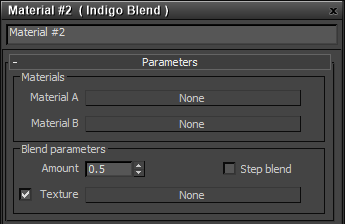The Indigo Material in 3ds Max allows you to switch between the various basic material types Indigo supports, specifically Diffuse / Oren-Nayar for rough reflecting materials (e.g. matte paint, chalk), Diffuse transmitter for rough transmitting materials (e.g. lamp shades, curtains), Phong for smooth reflective materials (e.g. metals, plastic) and Specular / glossy transparent for water or glass (both smooth and frosted).
There are also three more complex Indigo material types, which use other Indigo materials as sub-materials: Blend, Coating and Double sided.
Indigo materials can be found in the Indigo Renderer sub-menu when creating materials:

Diffuse / Oren-Nayar
For more information about the Diffuse and Oren-Nayar materials, please click the links to see the relevant documentation pages.

Diffuse material settings:
- Albedo - The material reflectance colour.
- Sigma - The roughness, where 0.0 is perfectly diffuse and 0.3 is very rough. For motion information on this parameter please see the Oren-Nayar documentation.
Diffuse transmitter
For more information about this material type please see the Diffuse transmitter material documentation.

Diffuse material settings:
- Albedo - The material transmittance colour.
Phong
For more information about this material type please see the Phong material documentation.

- Diffuse - The colour of the diffuse base (or substrate).
- IOR - Controls the influence of the glossy coating; higher values produce stronger specular reflection. The IOR should be set to the real-world value for the material, if available; for example, the IOR of plastics is around 1.5 to 1.6, and oil paint binder has an IOR of around 1.5.
- Exponent - The exponent of the Phong specular highlight; larger values (e.g. 1000+) produce sharper highlights, while low values (e.g. 10) are quite rough.
- Complex IOR - Allows you to select from a list of lab-measured metal reflectance data. This overrides the IOR and Diffuse settings.
- Fresnel scale - Allows you to adjust the strength of the Fresnel reflection falloff.
Specular / glossy transparent
For more information about the Specular and Glossy transparent materials, please click the links to see the relevant documentation pages.

- Exponent - The Phong glossy reflection and refraction exponent. Set to a very large value (such as 1 million) for perfect specular / no glossiness.
- IOR - The index of refraction of the medium contained in this material; water has an IOR of ~1.33, diamond ~2.4.
- Precedence - The precedence of the medium inside this material. If there are multiple media occupying the same volume of space (e.g. ice in water in air), the one with highest precedence is used.
- Dispersion - Enables wavelength-dependent refraction (dispersion). Note that this can take significantly longer to converge (tip: use MLT).
- Absorption Strength - Scales the material transmittance colour.
- Transmittance - The material transmittance colour.
- Scattering Strength - Scales the scattering spectrum.
- Scattering Spectrum - Defines the (possibly wavelength-dependent) scattering spectrum. Note that this can take significantly longer to converge (tip: use MLT).
- Phase function - The phase function used to describe scattering in the medium.
- G param - The Henyey-Greenstein G parameter, which specifies the preference for forwards (G > 0), backwards (G < 0) or uniform (G = 0) scattering.
Blend
For more information about the Blend material, please click the link to see the relevant documentation page.

Blend material settings:
- Material A - The first material used for blending.
- Material B - The second material used for blending.
- Blend Amount - A constant blending factor; 1.0 means 100% of Material A is used, 0.0 means 100% of material B is used.
- Step blend - Disables partial blends so the result is either material A or B, depending on whether the blend amount (constant or map) is >= 0.5.
- Texture - Allows you to use a texture map to control blending.
Coating
For more information about the Coating material, please click the link to see the relevant documentation page.

Coating material settings:
- Substrate - The base material which lies underneath the coating.
- Thickness - The coating thickness in millimetres.
- Roughness - Specifies the roughness of the coating, where 0 is perfect specular reflection and 1 is very rough.
- Fresnel scale - Allows you to adjust the strength of the Fresnel reflection falloff.
- IOR - The index of refraction of the coating medium.
- Interference - Enables the simulation of light interference in the coating, works best with thin coatings.
Double-sided
For more information about the Double-sided thin material, please click the link to see the relevant documentation page.

Front and Back material settings:
- Material - The material for the front- or back-facing side.
- Roughness - Specifies the roughness of the material's coating, where 0 is perfect specular reflection and 1 is very rough.
- Fresnel scale - Allows you to adjust the strength of the Fresnel reflection falloff.
- Fraction - The blending fraction between the front and back sides.
- Transmittance - The material transmittance colour.
- IOR - The index of refraction of the coating medium.

